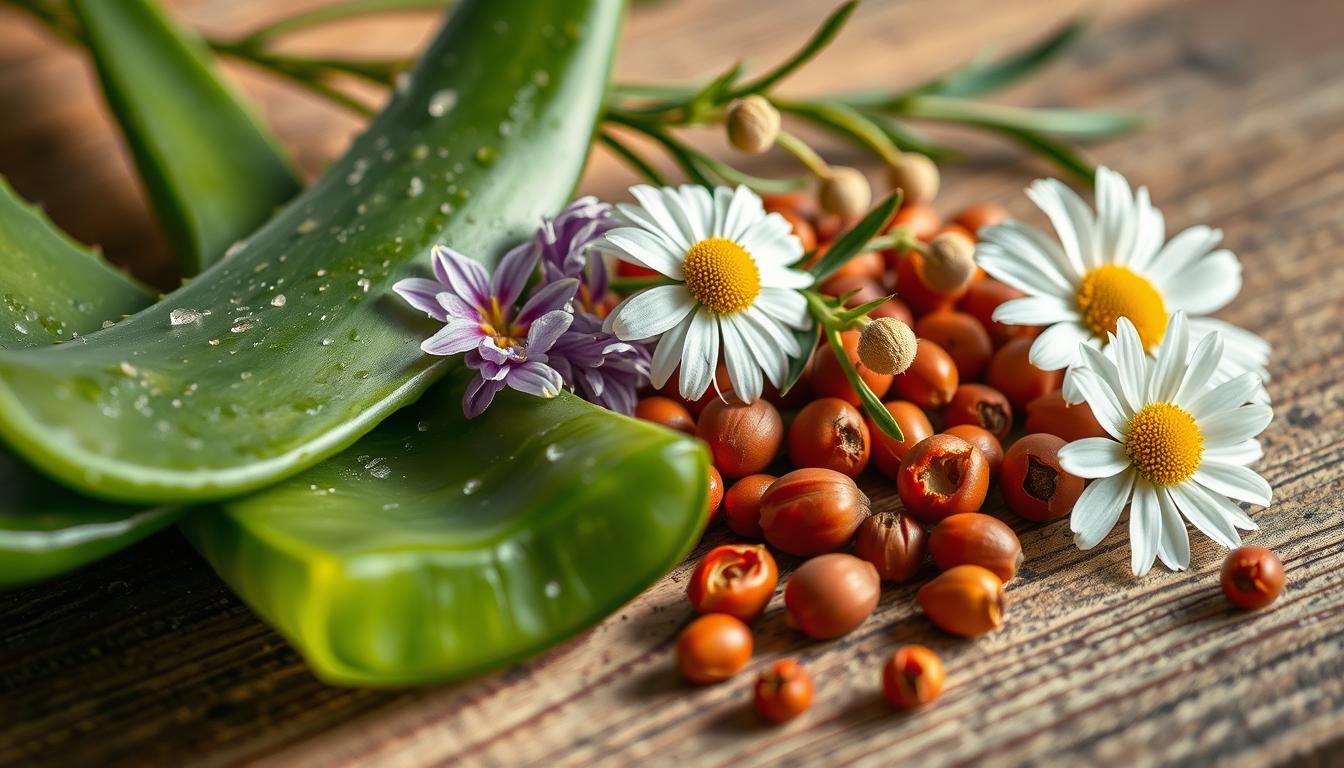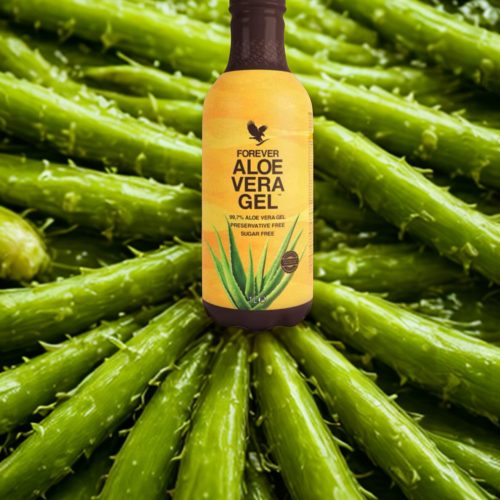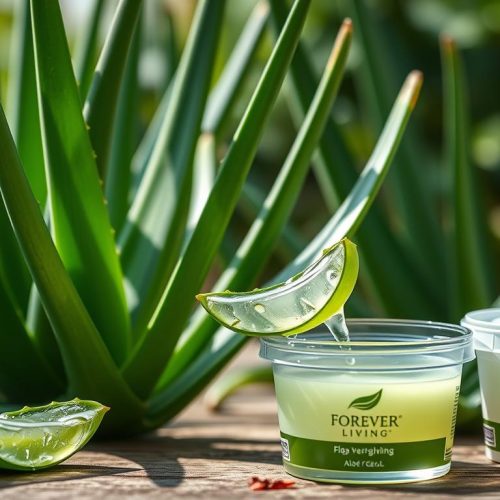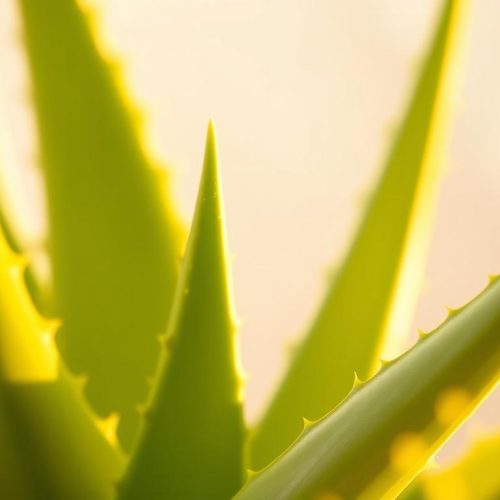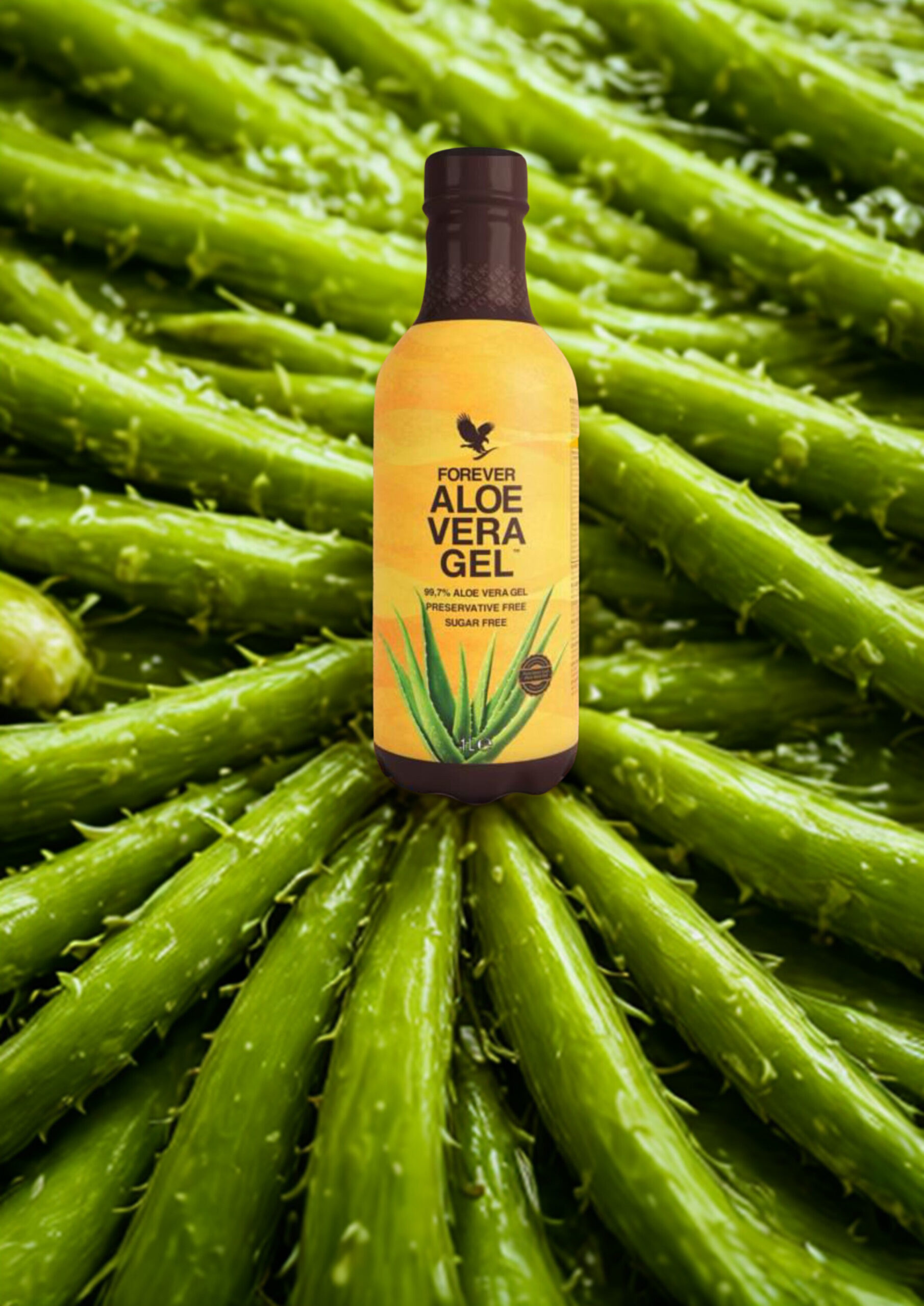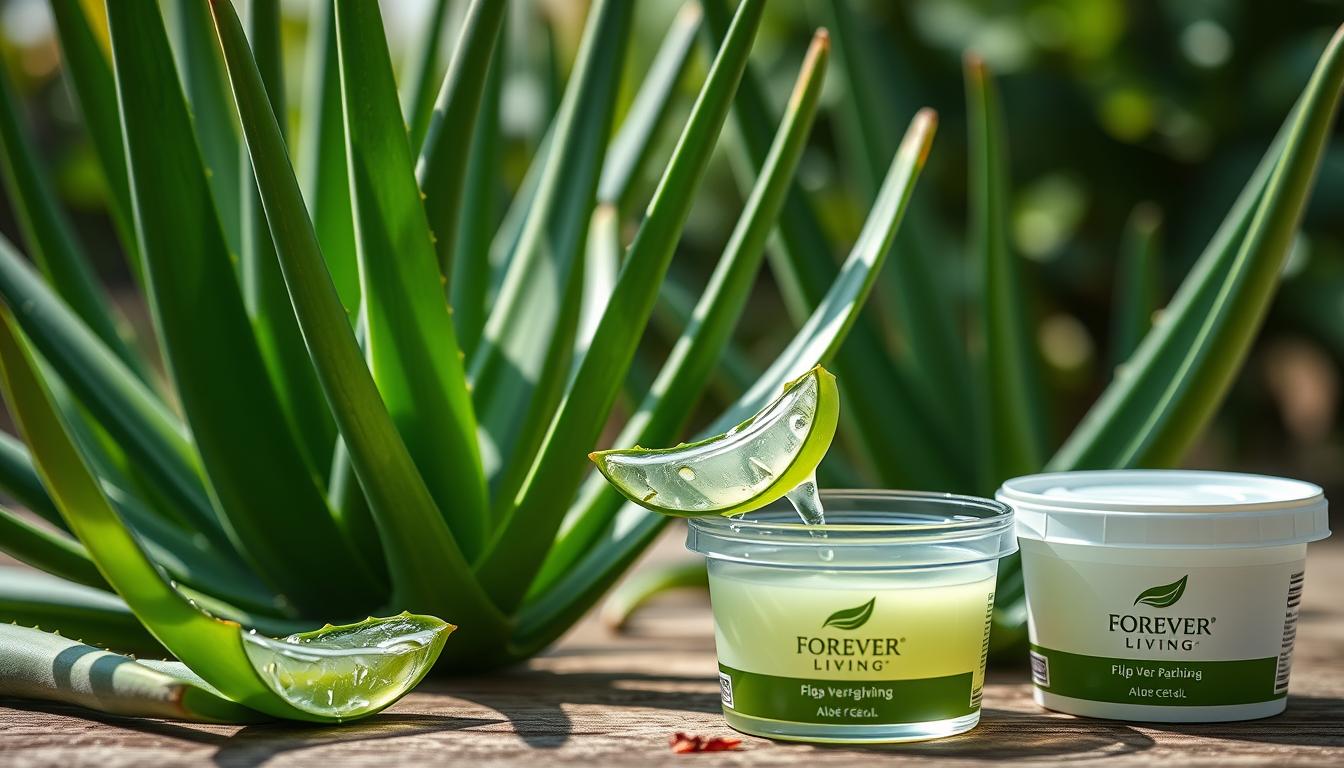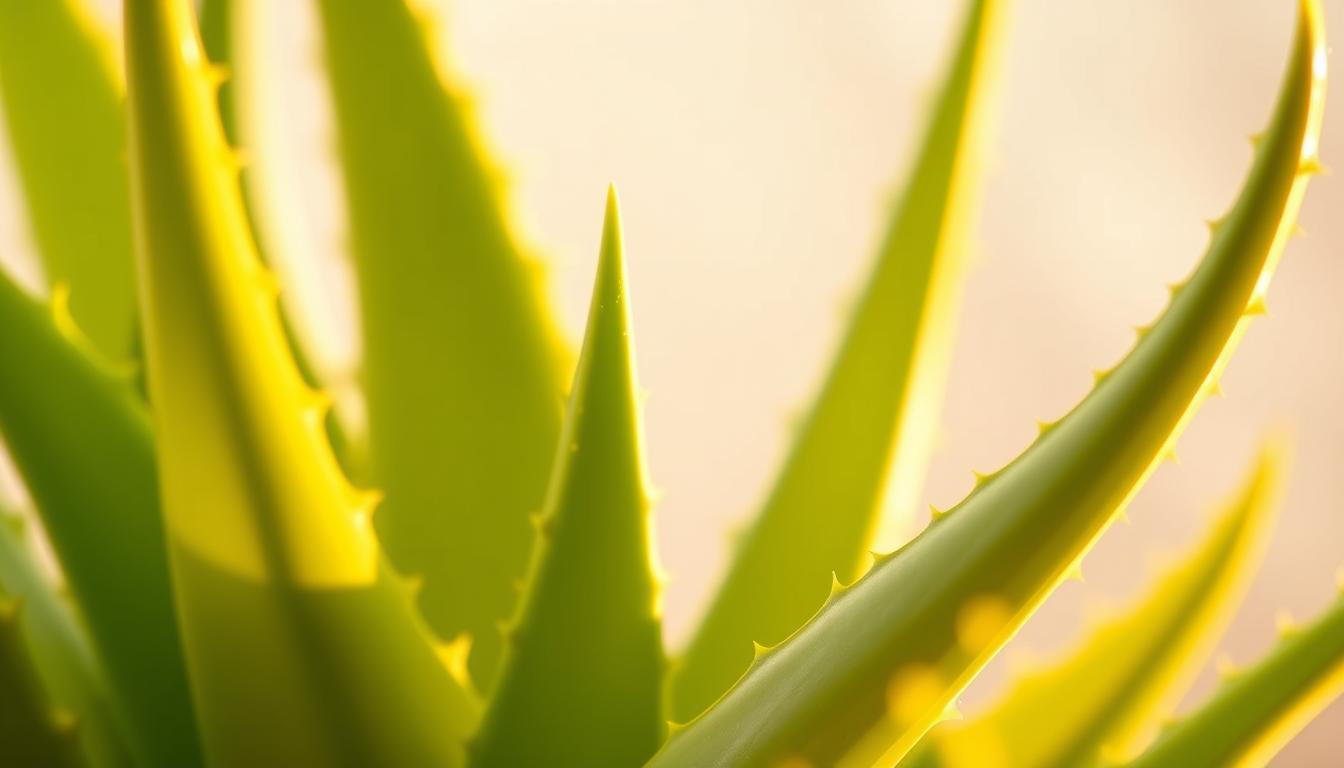Did you know that nearly 80% of people worldwide suffer from some form of skin issue, ranging from acne to dryness and signs of aging? Nature offers a simple, effective solution: aloe vera. Known for its soothing and rejuvenating properties, aloe vera has been used for centuries to promote healthy, glowing skin.
Rich in vitamins A, C, and E, as well as minerals and antioxidants, aloe vera provides hydration, reduces inflammation, and stimulates collagen production. This makes it an ideal ingredient for DIY skincare routines, particularly for those dealing with acne, dryness, or looking for anti-aging solutions.
By incorporating DIY aloe vera face masks into your skincare regimen, you can harness the power of this natural ingredient to address various skin concerns. Whether you’re looking to soothe acne, moisturize dry skin, or combat signs of aging, aloe vera can be a valuable addition to your natural skincare routine.
- The Natural Skincare Power of Aloe Vera
- Understanding Aloe Vera's Beneficial Composition
- 4 Essential Benefits of Aloe Vera for All Skin Types
- Harvesting and Preparing Fresh Aloe Vera Gel
- Effective DIY Aloe Vera Face Masks for Acne-Prone Skin
- Hydrating Aloe Vera Face Masks for Dry Skin
- Anti-Aging Aloe Vera Face Mask Recipes
- Preparation and Application Tips for DIY Aloe Vera Face Masks
- Storage and Shelf Life of Homemade Aloe Vera Masks
- Precautions and Potential Side Effects
- Conclusion
- FAQ
- What are the benefits of using aloe vera face masks for acne-prone skin?
- Can aloe vera face masks help with dry skin?
- How do I harvest and prepare fresh aloe vera gel for face masks?
- What are some effective aloe vera face mask recipes for anti-aging?
- How often should I use aloe vera face masks?
- Can I store homemade aloe vera face masks in the refrigerator?
- What are the signs that my aloe vera mask has expired?
- Are there any precautions I should take before using aloe vera face masks?
- Can aloe vera face masks help reduce the appearance of fine lines and wrinkles?
- How do I prepare my skin before applying an aloe vera face mask?
- The Natural Skincare Power of Aloe Vera
- Understanding Aloe Vera's Beneficial Composition
- 4 Essential Benefits of Aloe Vera for All Skin Types
- Harvesting and Preparing Fresh Aloe Vera Gel
- Effective DIY Aloe Vera Face Masks for Acne-Prone Skin
- Hydrating Aloe Vera Face Masks for Dry Skin
- Anti-Aging Aloe Vera Face Mask Recipes
- Preparation and Application Tips for DIY Aloe Vera Face Masks
- Storage and Shelf Life of Homemade Aloe Vera Masks
- Precautions and Potential Side Effects
- Conclusion
- FAQ
- What are the benefits of using aloe vera face masks for acne-prone skin?
- Can aloe vera face masks help with dry skin?
- How do I harvest and prepare fresh aloe vera gel for face masks?
- What are some effective aloe vera face mask recipes for anti-aging?
- How often should I use aloe vera face masks?
- Can I store homemade aloe vera face masks in the refrigerator?
- What are the signs that my aloe vera mask has expired?
- Are there any precautions I should take before using aloe vera face masks?
- Can aloe vera face masks help reduce the appearance of fine lines and wrinkles?
- How do I prepare my skin before applying an aloe vera face mask?
Key Takeaways
- Discover the benefits of using aloe vera for skin health.
- Learn how to create DIY aloe vera face masks for acne, dryness, and anti-aging.
- Understand the importance of natural ingredients in skincare.
- Explore the anti-inflammatory and hydrating properties of aloe vera.
- Find out how to incorporate aloe vera into your skincare routine.
The Natural Skincare Power of Aloe Vera
With its rich composition and versatility, aloe vera stands out as a premier ingredient in natural skincare routines. Its benefits for the skin are multifaceted, making it a popular choice for addressing various skin concerns.
What Makes Aloe Vera a Skincare Superstar
Aloe vera is renowned for its hydrating properties, thanks to its high water content, making it an excellent moisturizer. It also boasts anti-inflammatory and antibacterial properties, which are crucial for soothing and protecting the skin.
- Hydrates the skin without clogging pores
- Reduces inflammation and irritation
- Fights bacteria that can cause acne
Scientific Evidence Behind Aloe Vera's Skin Benefits
Numerous studies have validated the benefits of aloe vera for the skin. Its anti-inflammatory properties have been shown to reduce redness and irritation, while its antibacterial properties help combat acne-causing bacteria. Moreover, aloe vera’s ability to stimulate collagen production contributes to improved skin elasticity and reduced fine lines.
The scientific evidence supporting aloe vera’s skincare benefits is compelling, making it a trusted ingredient in natural skincare regimens. Its unique composition and versatility make it suitable for various skin types, from dry and sensitive to acne-prone skin.
Understanding Aloe Vera's Beneficial Composition
Aloe vera’s remarkable skincare benefits can be attributed to its rich and diverse composition. This succulent plant is packed with a variety of nutrients and compounds that work synergistically to nourish and protect the skin.
Key Nutrients and Compounds in Aloe Vera
Aloe vera is renowned for its high content of vitamins A, C, and E, which are potent antioxidants that help protect the skin from environmental stressors and promote overall skin health. Additionally, it contains a range of minerals, including calcium, magnesium, and zinc, which are crucial for maintaining healthy skin.
The gel of the aloe vera plant is also rich in amino acids, the building blocks of proteins, which help in repairing and rejuvenating the skin. Furthermore, aloe vera contains polysaccharides, which have hydrating properties and help in retaining moisture in the skin.
| Nutrient/Compound | Benefit to Skin |
|---|---|
| Vitamin A | Promotes cell turnover and collagen production |
| Vitamin C | Boosts collagen production and brightens skin |
| Vitamin E | Protects against oxidative stress and promotes skin healing |
| Amino Acids | Repairs and rejuvenates skin |
| Polysaccharides | Hydrates and retains moisture in the skin |
How Aloe Vera Works on Different Skin Types
Aloe vera’s versatile composition makes it beneficial for various skin types. For acne-prone skin, aloe vera’s anti-inflammatory and antimicrobial properties help in reducing acne and preventing future breakouts. Its soothing effect can calm irritated skin, reducing redness and inflammation.
For dry skin, aloe vera’s hydrating properties help in locking in moisture, leaving the skin feeling soft and supple. The vitamins and minerals in aloe vera also support the skin’s natural barrier function, enhancing its ability to retain moisture.
Even for mature skin, aloe vera’s antioxidant properties help in combating signs of aging, such as fine lines and wrinkles, by protecting the skin from oxidative stress and promoting collagen production.
“Aloe vera’s rich composition makes it an excellent ingredient for skincare, offering benefits that range from hydration and soothing to anti-aging and skin protection.”
4 Essential Benefits of Aloe Vera for All Skin Types
Aloe vera is a versatile skincare ingredient that offers numerous benefits for various skin types. Its unique composition makes it an ideal natural solution for addressing different skin concerns.
Deep Hydration Without Clogging Pores
Aloe vera provides deep hydration to the skin without clogging pores, making it suitable for both dry and oily skin types. Its water content helps to moisturize the skin, while its lightweight texture ensures that pores remain unclogged.
The hydrating properties of aloe vera are attributed to its rich content of vitamins A, C, and E, along with minerals like calcium and magnesium. These nutrients work together to lock in moisture and soothe dryness.
Anti-Inflammatory Effects for Irritated Skin
Aloe vera is renowned for its anti-inflammatory properties, which help to calm irritated skin and reduce redness. This makes it an effective remedy for skin conditions such as acne, rosacea, and eczema.
The anti-inflammatory compounds in aloe vera, including aloin and aloe-emodin, work to minimize swelling and promote healing. Regular use can lead to a significant reduction in skin irritation.
Collagen Stimulation for Improved Elasticity
Aloe vera stimulates collagen production, which is essential for maintaining skin elasticity and firmness. As we age, collagen production naturally decreases, leading to wrinkles and sagging skin.
By promoting collagen synthesis, aloe vera helps to improve skin texture and reduce the appearance of fine lines and wrinkles. This results in a more youthful and radiant complexion.
Antibacterial Action Against Acne-Causing Bacteria
Aloe vera’s antibacterial properties make it effective against acne-causing bacteria, helping to prevent breakouts and promote clearer skin. Its gentle nature ensures that it does not strip the skin of its natural oils, maintaining the skin’s natural barrier.
- Reduces acne by fighting bacteria
- Soothes inflamed skin
- Promotes healing of acne lesions
In summary, aloe vera offers a range of benefits that cater to different skin needs, from hydration and anti-inflammatory effects to collagen stimulation and antibacterial action. Incorporating aloe vera into your skincare routine can lead to healthier, more resilient skin.
Harvesting and Preparing Fresh Aloe Vera Gel
To reap the benefits of aloe vera, it’s crucial to understand how to harvest and prepare its gel correctly. Fresh aloe vera gel can be extracted from the leaves of the aloe vera plant, providing a potent ingredient for various skincare applications.
Selecting and Cutting Aloe Vera Leaves
The first step in harvesting aloe vera gel is selecting the right leaves. Choose mature, thick leaves from the outer part of the plant, as they contain more gel. Avoid using leaves that are too old or too young, as they may not provide the optimal amount of gel or may be too fibrous.
When cutting the leaves, use a sharp, clean knife to minimize damage to the plant and prevent contamination. Cut the leaves at the base, as close to the soil as possible, to obtain the maximum amount of gel.
Extracting and Storing Pure Aloe Gel
To extract the gel, carefully peel the outer layer of the aloe leaf, exposing the clear gel inside. Scoop out the gel with a spoon, taking care not to mix it with the latex, a yellow sap found just beneath the leaf’s skin, as it can be irritating to some skin types.
Once extracted, the aloe gel can be stored in an airtight container in the refrigerator to prolong its freshness. It’s essential to use clean equipment and storage containers to prevent contamination.
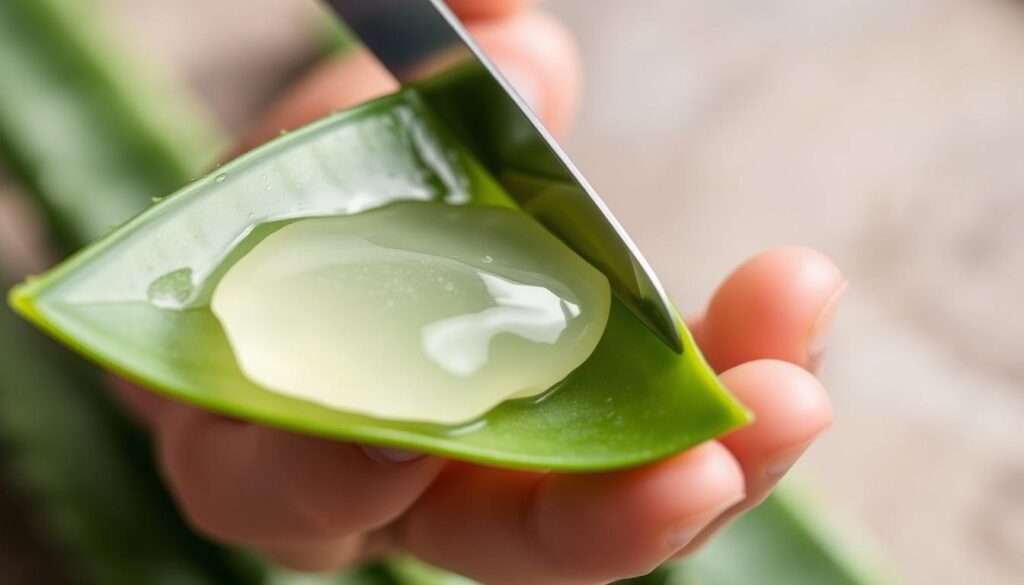
| Storage Method | Duration | Notes |
|---|---|---|
| Refrigeration | Up to 1 week | Store in an airtight container |
| Freezing | Up to 6 months | Use ice cube trays for convenient portions |
By following these steps, you can enjoy the numerous benefits of fresh aloe vera gel in your skincare routine.
Effective DIY Aloe Vera Face Masks for Acne-Prone Skin
Effective aloe vera face masks can help combat acne and reduce inflammation. Aloe vera’s anti-inflammatory and antibacterial properties make it an ideal ingredient for acne-prone skin. By combining aloe vera with other natural ingredients, you can create face masks that target acne and promote healthier skin.
Aloe Vera, Honey, and Cinnamon Antibacterial Mask
This mask combines the antibacterial properties of honey and cinnamon with the soothing effects of aloe vera. To make this mask, mix 2 tablespoons of aloe vera gel with 1 tablespoon of honey and 1 teaspoon of cinnamon powder. Apply the mask to your face and leave it on for 10-15 minutes before rinsing with warm water.
The antibacterial properties of honey and cinnamon help to combat acne-causing bacteria, while aloe vera reduces inflammation and soothes the skin.
Aloe Vera and Tea Tree Oil Blemish Fighter
Tea tree oil is known for its acne-fighting properties, making it a great addition to an aloe vera face mask. To make this mask, mix 2 tablespoons of aloe vera gel with 5-7 drops of tea tree oil. Apply the mask to individual blemishes or to the entire face, leaving it on overnight before rinsing with warm water in the morning.
Tea tree oil’s antimicrobial properties help to reduce acne, while aloe vera calms the skin and reduces redness.
Aloe Vera and Lemon Juice Brightening Treatment
Lemon juice has natural astringent and brightening properties, making it a great addition to an aloe vera face mask. To make this mask, mix 2 tablespoons of aloe vera gel with 1 tablespoon of freshly squeezed lemon juice. Apply the mask to your face and leave it on for 10-15 minutes before rinsing with warm water.
The citric acid in lemon juice helps to brighten the skin and reduce the appearance of acne scars, while aloe vera soothes and hydrates the skin.
Hydrating Aloe Vera Face Masks for Dry Skin
Dry skin can be a persistent issue, but aloe vera face masks offer a natural solution. Aloe vera is well-known for its moisturizing properties, making it an ideal ingredient for combating dryness and restoring skin health.
Aloe Vera and Avocado Moisture Boost
Combining aloe vera with avocado creates a potent moisturizing mask. Avocado is rich in healthy fats and vitamins that nourish dry skin, while aloe vera provides hydration and soothes irritation. To make this mask, mash a ripe avocado and mix it with 2 tablespoons of aloe vera gel. Apply it to your face and leave it on for 15-20 minutes before rinsing with lukewarm water.
Benefits: Deeply moisturizes, nourishes, and soothes dry skin.
Aloe Vera with Yogurt and Honey
Yogurt and honey are excellent companions to aloe vera for dry skin. Yogurt contains lactic acid that gently exfoliates, while honey is a natural humectant that locks in moisture. Mix 1 tablespoon of yogurt, 1 teaspoon of honey, and 2 tablespoons of aloe vera gel. Apply this mixture to your face and let it sit for 10-15 minutes. Rinse with warm water, then pat dry.
This combination not only hydrates but also helps in gently removing dead skin cells.
Aloe Vera and Coconut Oil Overnight Mask
For an intense hydration treatment, try an overnight mask with aloe vera and coconut oil. Coconut oil is rich in fatty acids that help repair dry skin, while aloe vera provides soothing hydration. Mix equal parts of aloe vera gel and melted coconut oil. Apply this mixture to your face before bed, and wash it off with lukewarm water in the morning.
- Hydrates dry skin overnight
- Repairs and nourishes the skin
- Leaves skin feeling soft and supple
These hydrating aloe vera face masks are simple to make and offer significant benefits for dry skin. By incorporating these masks into your skincare routine, you can enjoy healthier, more hydrated skin.
Anti-Aging Aloe Vera Face Mask Recipes
Aloe vera’s anti-aging properties make it an ideal ingredient for homemade face masks. As we age, our skin’s natural ability to regenerate and maintain elasticity diminishes, leading to wrinkles and fine lines. Aloe vera, rich in vitamins A, C, and E, along with its antioxidant properties, helps combat these signs of aging, promoting a smoother and more youthful complexion.
Aloe Vera and Egg White Firming Mask
This mask combines the firming properties of egg whites with the nourishing benefits of aloe vera. Egg whites are known for their ability to tighten skin, reducing the appearance of pores and fine lines.
- 2 tablespoons of aloe vera gel
- 1 egg white
- 1 teaspoon of lemon juice
Mix all ingredients until smooth and apply to the face. Leave on for 15-20 minutes before rinsing with lukewarm water.
Aloe Vera with Vitamin E and Rosehip Oil
Vitamin E and rosehip oil are potent antioxidants that work synergistically with aloe vera to rejuvenate the skin. This mask is particularly beneficial for dry or mature skin.
- 2 tablespoons of aloe vera gel
- 1 capsule of vitamin E oil
- 1 teaspoon of rosehip oil
Combine the ingredients and apply to the face and neck. Leave on overnight and rinse off in the morning.
Aloe Vera and Green Tea Antioxidant Treatment
Green tea is rich in antioxidants that help protect the skin from environmental stressors and reduce signs of aging. When combined with aloe vera, it creates a powerful anti-aging treatment.
- 2 tablespoons of aloe vera gel
- 1 teaspoon of cooled green tea
- 1 teaspoon of honey
Mix the ingredients and apply to the face. Leave on for 10-15 minutes before rinsing with cool water.
Here’s a summary of the benefits of these masks in a comparative table:
| Mask Ingredients | Primary Benefits | Skin Type |
|---|---|---|
| Aloe Vera, Egg White | Firming, Tightening | All, especially mature |
| Aloe Vera, Vitamin E, Rosehip Oil | Nourishing, Rejuvenating | Dry, Mature |
| Aloe Vera, Green Tea | Antioxidant, Protective | All, especially sensitive |
By incorporating these anti-aging aloe vera face masks into your skincare routine, you can harness the natural power of aloe vera to achieve a more youthful and radiant complexion.
Preparation and Application Tips for DIY Aloe Vera Face Masks
To get the most out of your DIY aloe vera face masks, it’s essential to prepare and apply them correctly. Proper preparation and application can significantly enhance the effectiveness of these masks, ensuring you reap the maximum benefits for your skin.
Preparing Your Skin Before Application
Before applying any face mask, it’s crucial to prepare your skin. Start by cleansing your face with a gentle cleanser to remove dirt and impurities. Pat dry your skin with a clean towel; do not rub, as this can irritate the skin. For better absorption, consider steaming your face or using a toner to open up your pores.
As skincare expert, Dr. Joshua Zeichner, notes, “Steaming your face can help to open up the pores, allowing the mask to penetrate more deeply and effectively.” This simple step can make a significant difference in the mask’s effectiveness.
Correct Application Methods for Maximum Absorption
When applying your DIY aloe vera face mask, use a brush or your fingertips to apply an even layer across your face. Avoid the delicate skin around your eyes and mouth. Relax for 15-20 minutes while the mask works its magic. To enhance absorption, you can gently massage the mask into your skin in circular motions.
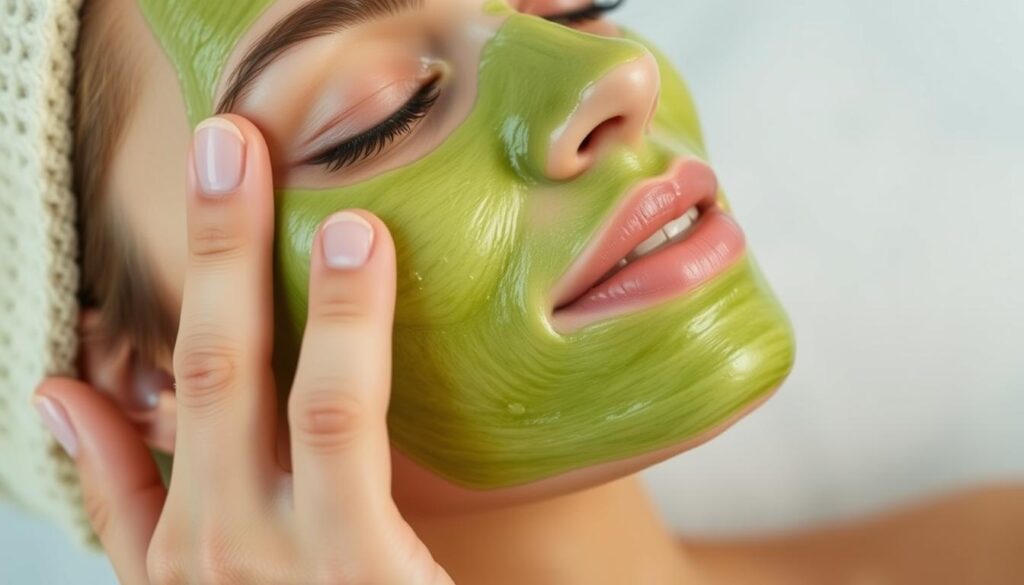
For an added treat, consider using a face mask brush that can help in evenly distributing the mask and can be gentler on the skin than using your fingers.
Recommended Treatment Duration and Frequency
The duration for leaving a face mask on can vary, but generally, 15-20 minutes is sufficient. Avoid leaving it on for too long, as this can cause dryness or irritation. As for frequency, using a face mask 1-2 times a week is a good starting point. Adjust based on your skin’s response and needs.
As quoted in a study published in the Journal of Clinical and Aesthetic Dermatology, “Face masks can provide an intensive dose of ingredients to the skin, and when used correctly, can be a valuable addition to a skincare routine.” Be mindful of your skin’s response and adjust your usage accordingly.
Storage and Shelf Life of Homemade Aloe Vera Masks
Storing your homemade aloe vera face masks properly can extend their shelf life and maintain their potency. When you invest time and effort into creating these masks, you want to ensure they remain effective until you’re ready to use them.
Refrigeration Guidelines for Fresh Ingredients
To keep your homemade aloe vera masks fresh, it’s crucial to store them in the refrigerator. The cool temperature slows down the growth of bacteria and other microorganisms, thereby extending the shelf life of the masks. Always use airtight containers to prevent contamination and exposure to air, which can cause the masks to spoil faster.
When storing in the refrigerator, ensure the masks are kept away from strong-smelling foods, as aloe vera can absorb odors easily. Label your containers with the date of preparation so you can keep track of how long they’ve been stored.
Signs Your Aloe Vera Mask Has Expired
Even with proper storage, homemade aloe vera masks have a limited shelf life. Typically, they can last between 3 to 7 days when stored in the refrigerator. It’s essential to check for signs of spoilage before using them. If you notice any off smell, mold, or a change in texture or color, it’s best to discard the mask.
Using expired or spoiled face masks can lead to skin irritation or infections. Always inspect your masks before application, and when in doubt, it’s better to prepare a fresh batch.
Precautions and Potential Side Effects
While aloe vera is renowned for its skincare benefits, it’s crucial to be aware of potential precautions and side effects. Aloe vera masks are generally considered safe for most skin types, but like any skincare product, they can cause adverse reactions in some individuals.
Performing a Patch Test Before Full Application
Before applying an aloe vera mask to your entire face, it’s essential to perform a patch test. This simple step can help you identify any potential allergic reactions or sensitivity. To do a patch test, apply a small amount of the mask to a discreet area of your skin, such as behind your ear or on your wrist. Wait 24 hours to observe any reactions.
Common Allergic Reactions to Watch For
Although rare, some people may experience allergic reactions to aloe vera. Common symptoms include redness, itching, swelling, or a rash at the application site. If you notice any of these reactions, discontinue use immediately. In cases of severe reactions, consult a dermatologist for advice.
When to Avoid Aloe Vera Masks
There are certain situations where it’s advisable to avoid using aloe vera masks or to exercise caution. If you have open wounds, severe acne, or sensitive skin conditions like eczema, consult with a dermatologist before use. Pregnant or breastfeeding women should also consult a healthcare professional before incorporating aloe vera masks into their skincare routine.
By being aware of these precautions and taking the necessary steps, you can safely enjoy the benefits of aloe vera masks for healthier, more radiant skin.
Conclusion
Incorporating aloe vera face masks into your skincare routine can be a game-changer for various skin concerns, from acne and dryness to anti-aging. The natural skincare benefits of aloe vera make it an ideal ingredient for DIY skincare enthusiasts.
By harnessing the power of aloe vera, you can create effective face masks that cater to your specific skin needs. Whether you’re looking to soothe acne-prone skin, hydrate dry skin, or combat signs of aging, aloe vera face masks offer a natural and nourishing solution.
With the simple, easy-to-follow recipes and tips outlined in this article, you can start enjoying the benefits of aloe vera face masks in the comfort of your own home. So why not give DIY skincare a try and experience the transformative power of aloe vera for yourself?
FAQ
What are the benefits of using aloe vera face masks for acne-prone skin?
Aloe vera face masks can help reduce acne due to their antibacterial properties, which fight acne-causing bacteria, and their anti-inflammatory effects, which soothe irritated skin.
Can aloe vera face masks help with dry skin?
Yes, aloe vera face masks are beneficial for dry skin as they provide deep hydration without clogging pores, helping to lock in moisture and soothe dryness.
How do I harvest and prepare fresh aloe vera gel for face masks?
To harvest aloe vera gel, select a healthy aloe vera leaf, cut it open, and scoop out the gel. Store the gel in an airtight container in the refrigerator to keep it fresh.
What are some effective aloe vera face mask recipes for anti-aging?
Some effective anti-aging aloe vera face mask recipes include mixing aloe vera gel with egg white for a firming mask, with vitamin E and rosehip oil for a nourishing mask, or with green tea for an antioxidant treatment.
How often should I use aloe vera face masks?
The frequency of using aloe vera face masks depends on your skin type and concerns. Generally, using a face mask once or twice a week is recommended for most skin types.
Can I store homemade aloe vera face masks in the refrigerator?
Yes, homemade aloe vera face masks can be stored in the refrigerator to prolong their shelf life. It’s essential to store them in airtight containers and check for signs of spoilage before use.
What are the signs that my aloe vera mask has expired?
Signs that your aloe vera mask has expired include an off smell, slimy texture, or mold growth. If you notice any of these signs, it’s best to discard the mask.
Are there any precautions I should take before using aloe vera face masks?
Yes, it’s recommended to perform a patch test before using aloe vera face masks to check for any allergic reactions. Additionally, avoid using aloe vera masks if you have open wounds or sensitive skin conditions.
Can aloe vera face masks help reduce the appearance of fine lines and wrinkles?
Yes, aloe vera face masks can help reduce the appearance of fine lines and wrinkles due to their collagen-stimulating properties, which improve skin elasticity.
How do I prepare my skin before applying an aloe vera face mask?
Before applying aloe vera face masks, cleanse your skin thoroughly and pat it dry. This helps ensure maximum absorption of the mask’s benefits.
For world’s best Aloe Vera products Country Wise:
INDIA: CLICK HERE
USA: CLICK HERE
CANADA: CLICK HERE
AUSTRALIA: CLICK HERE
UNITED KINGDOM: CLICK HERE
